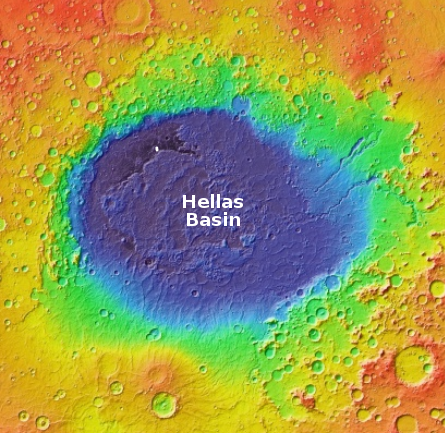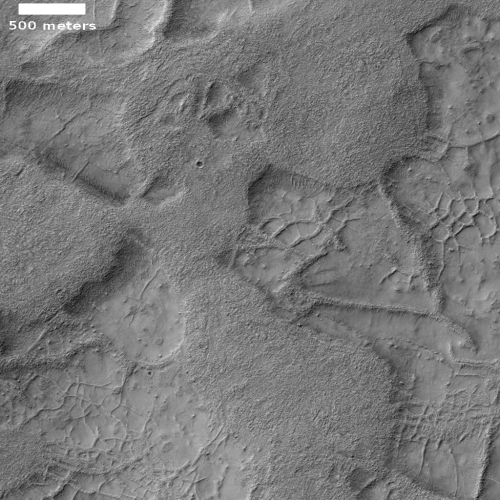Boxwork in the basement of Mars
Cool image time! The photo to the right, rotated, cropped, and reduced to post here, shows what resembles closely what in Earth caves are called boxwork, polygonal ridges sticking out from the bedrock and usually indicating cracks filled with harder material that resist erosion.
Taken by the high resolution camera on Mars Reconnaissance Orbiter (MRO) on March 23, 2021, what makes this boxwork especially interesting is its size and location. On Earth cave boxwork generally ranges from a few inches to a few feet across. Not only do these Martian ridges range from 100 feet to a half mile in length, they are located at the lowest point in Hellas Basin, the basement of Mars. In fact, this spot is as close as you can get to Mars’ Death Valley, as shown by the overview map below.

The white box indicates the location of the boxwork image. The darkest blue color indicates the deepest spot, which sits more than 26,000 feet (about five miles) below the Martian “sea level”, deeper than Mount Everest is high.
What formed the ridges? According to this 2017 paper, there are many types of such polygon ridges on Mars, likely formed from a variety of processes. However,
Hellas Basin is host to a fourth type of ridge morphology consisting of large, thick, light-toned ridges forming regular polygons at several superimposed scales. While still enigmatic, these are most likely to be the result of sediment-filled fractures.
In other words, the fractures are thought to be are filled with some sort of material that when hardened is resistant to erosion. As you can see by the image, the only place the ridges are visible are in depressions where the surrounding material has started to disappear, leaving the ridges standing above the surrounding topography.
What is the material that is eroding away? Dust? And what are the ridges made of? Lava? While both are likely, both are also pure guesses based on the available data.
The deep location, however, suggests we are looking at some of the oldest geology on Mars, billions of years old and likely giving us a glimpse of the planet from its infancy. What this is telling us is right now unfortunately very difficult to figure out, because our information is so incomplete.
On Christmas Eve 1968 three Americans became the first humans to visit another world. What they did to celebrate was unexpected and profound, and will be remembered throughout all human history. Genesis: the Story of Apollo 8, Robert Zimmerman's classic history of humanity's first journey to another world, tells that story, and it is now available as both an ebook and an audiobook, both with a foreword by Valerie Anders and a new introduction by Robert Zimmerman.
The print edition can be purchased at Amazon or from any other book seller. If you want an autographed copy the price is $60 for the hardback and $45 for the paperback, plus $8 shipping for each. Go here for purchasing details. The ebook is available everywhere for $5.99 (before discount) at amazon, or direct from my ebook publisher, ebookit. If you buy it from ebookit you don't support the big tech companies and the author gets a bigger cut much sooner.
The audiobook is also available at all these vendors, and is also free with a 30-day trial membership to Audible.
"Not simply about one mission, [Genesis] is also the history of America's quest for the moon... Zimmerman has done a masterful job of tying disparate events together into a solid account of one of America's greatest human triumphs."--San Antonio Express-News
Cool image time! The photo to the right, rotated, cropped, and reduced to post here, shows what resembles closely what in Earth caves are called boxwork, polygonal ridges sticking out from the bedrock and usually indicating cracks filled with harder material that resist erosion.
Taken by the high resolution camera on Mars Reconnaissance Orbiter (MRO) on March 23, 2021, what makes this boxwork especially interesting is its size and location. On Earth cave boxwork generally ranges from a few inches to a few feet across. Not only do these Martian ridges range from 100 feet to a half mile in length, they are located at the lowest point in Hellas Basin, the basement of Mars. In fact, this spot is as close as you can get to Mars’ Death Valley, as shown by the overview map below.

The white box indicates the location of the boxwork image. The darkest blue color indicates the deepest spot, which sits more than 26,000 feet (about five miles) below the Martian “sea level”, deeper than Mount Everest is high.
What formed the ridges? According to this 2017 paper, there are many types of such polygon ridges on Mars, likely formed from a variety of processes. However,
Hellas Basin is host to a fourth type of ridge morphology consisting of large, thick, light-toned ridges forming regular polygons at several superimposed scales. While still enigmatic, these are most likely to be the result of sediment-filled fractures.
In other words, the fractures are thought to be are filled with some sort of material that when hardened is resistant to erosion. As you can see by the image, the only place the ridges are visible are in depressions where the surrounding material has started to disappear, leaving the ridges standing above the surrounding topography.
What is the material that is eroding away? Dust? And what are the ridges made of? Lava? While both are likely, both are also pure guesses based on the available data.
The deep location, however, suggests we are looking at some of the oldest geology on Mars, billions of years old and likely giving us a glimpse of the planet from its infancy. What this is telling us is right now unfortunately very difficult to figure out, because our information is so incomplete.
On Christmas Eve 1968 three Americans became the first humans to visit another world. What they did to celebrate was unexpected and profound, and will be remembered throughout all human history. Genesis: the Story of Apollo 8, Robert Zimmerman's classic history of humanity's first journey to another world, tells that story, and it is now available as both an ebook and an audiobook, both with a foreword by Valerie Anders and a new introduction by Robert Zimmerman.
The print edition can be purchased at Amazon or from any other book seller. If you want an autographed copy the price is $60 for the hardback and $45 for the paperback, plus $8 shipping for each. Go here for purchasing details. The ebook is available everywhere for $5.99 (before discount) at amazon, or direct from my ebook publisher, ebookit. If you buy it from ebookit you don't support the big tech companies and the author gets a bigger cut much sooner.
The audiobook is also available at all these vendors, and is also free with a 30-day trial membership to Audible.
"Not simply about one mission, [Genesis] is also the history of America's quest for the moon... Zimmerman has done a masterful job of tying disparate events together into a solid account of one of America's greatest human triumphs."--San Antonio Express-News



Holy Richard Hoagland Batman!
Where the atmosphere is thickest. I wonder if you could house over a cell…
The straight lines and intersections freak me out a little. Mars is so weird.